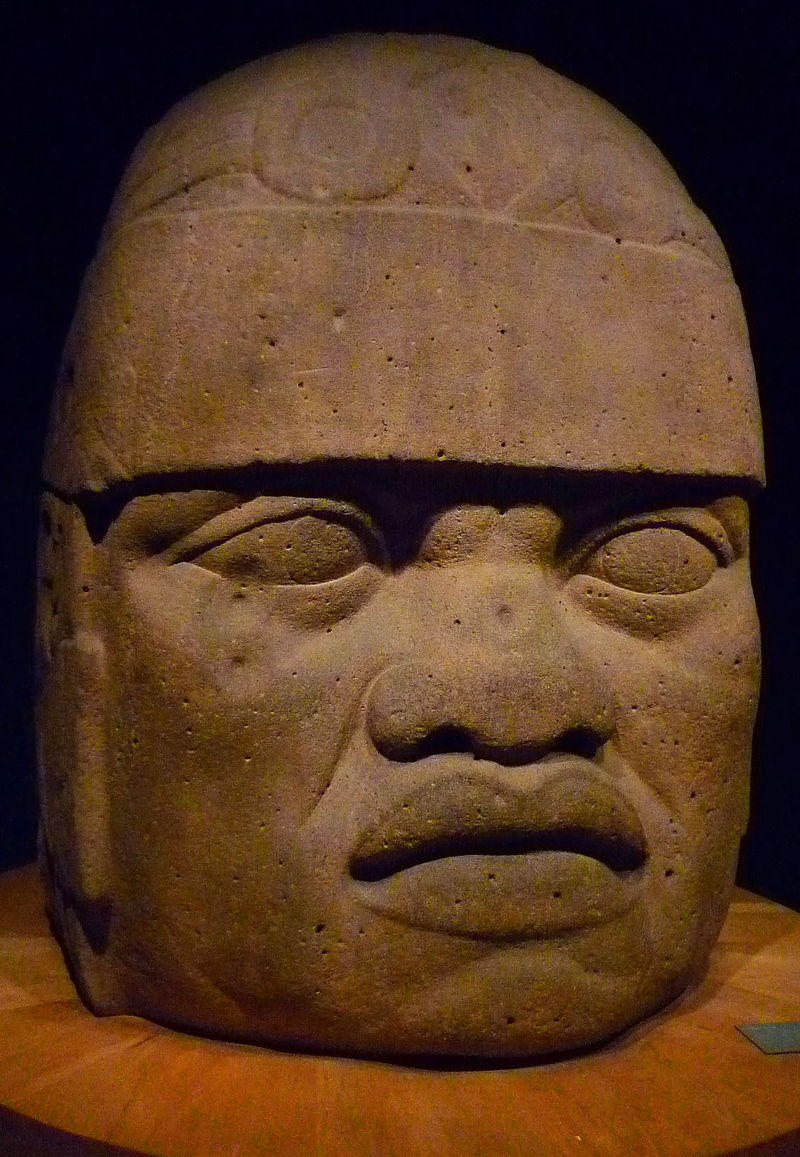Early American Civilizations

One of many pictures of Olmec Heads. (Creative Commons photo. Attribution to author and info can be found here)
Indigenous Americans had a much tougher time with inventions than the rest of the world did for a few important reasons.
- They were forced to invent everything separately from their peers in Eurasia, because they were outside of the sphere of cultural diffusion everyone else got to benefit from.
- They reach their destinations until thousands of years after the rest of the world.
These issues led the civilizations in the Western Hemisphere to be consistently behind their peers in many categories. For instance, archeologists of the nineteenth and twentieth centuries were baffled to find out that at no point did civilizations in the Americas invent basic concepts like the wheel. While this seems like a basic step that civilizations would need to take as it grew, the reality was that the evolution of civilization in the west was going to be different than that of the east. In reality, the civilizations of the Americas DID actually invent the wheel, but it was only used for children’s toys and wasn’t used for wheeled vehicles. After years of research the reason for this became clear; these civilizations lacked the animals with the size and temperament to pull carts & chariots. In the eyes of the indigenous Americans, the value of a chariot was lessened to the point that it wasn’t worth the work to develop one.
On the bright side, however, the same separation that caused them to seem behind others also allowed them to develop separate from the cultural norms that the rest of the world was based on. This created some ideas that were clearly superior to similar versions in the east. This is most clearly shown in the radically different approach to farming used by Indigenous Americans. Like the Eurasia, major civilizations weren’t created in the Americas until they had a crop that could feed larger populations, but unlike their peers, the Americans sort of engineered this staple crop. The maize that was found in the Americas at that time was much smaller and less sweet than what
we are used to in current maize (corn). Early Indigenous Americans actually bred corn over time to be larger and sweeter by only replanting those corn stalks with these traits. Unbeknownst to the Indigenous Americans, planting these crops together would create a sort of ancient version of genetic engineering process that created corn as we now know it. This crop would go on to turn into one of the most important sources of food in human history. The other concept that was superior to their peers was the farming process known as the “milpa.” This is the process by which farms rotate their crops in specific ways in order to balance the nutrients in the soil. They found that if they were rotated with certain crops, the farm would continue to be usable for centuries, and many farms were used this way. This is technically better than the system we use today, because adding fertilizer to soil will eventually strip the soil and cause it to be unusable for long periods of time.
The Olmec
The group known collectively as the Olmecs (1800-500 BCE) were, until recently, thought to be the first civilization of the Americas. They were believed to have laid the foundation for later cultures, and therefore were often referred to as the “mother culture” of the Americas. As archeology in the Americas has become more popular, we have seen a huge shift away from this narrative and towards one that is probably much more correct. What we have uncovered recently is that there were a handful of smaller societies that developed near each other in what is now Mexico known collectively as the La Venta Civilization. One of the 3 groups that are in this civilization was one that called themselves the Xi people (pronounced ‘shi’). The earliest archeologists to find evidence of these civilization referred to them as Olmec (meaning ‘land of rubber’) due to lack of knowledge as well as a known abundance of rubber in the area and the name stuck with historians.
The Xi people were one of only a few civilizations to be created in a rainforest environment, due to the incredible complexity it takes to farm in that environment. Farming here required so much more land than farming in other areas that it kept these people from living in close proximity with one another; and caused the cities to be ceremonial centers where people only went for church. This civilization was ‘rediscovered’ by archeologists when they unearthed these gigantic heads that were 6ft tall and 15ft around. We have since realized that these carved heads were images of the former king, who left them to make sure people thought he was still watching them after his death. Interestingly enough, when these heads were evaluated by forensic scientists, they found that these heads had the facial features of Africans instead of Indigenous Americans. From that moment on, the question of how African facial features were found in America at least a millennia before the life of Jesus started to change the mindset of many historians. These same stories get really interesting when you find that the Xi had multiple stories in their cultures of people come from the East in ships.
Despite all the changes in the way we think of the Xi/Olmecs, the similarities between they and the rest of the Central American civilizations is canny and will continue to be developed for years to come. The game Ulama is quite possibly the most widely used cultural similarity of the Americas. While the field and the rules changed slightly from place to place, most cultures in the Americas played some version of this ball game that seems to be a hybrid between basketball and soccer. The most interesting aspect of it is that the losers were sometimes put to death after the game was over, with some using one of the heads to help create the next ball for the game. The Xi/Olmec are also given a great deal of credit for their proficiency in math in comparison with others. It is possible that they were the first to create the mathematical concept of zero as a number that could be used and manipulated. This may not seem like much, but it is a major step on the road to higher mathematical ideas that would come later. Whether they were the first (as opposed to the Guptas in India) revolves around the interpretation of a date of an inscription on one of those giant heads. No one knows for sure which is first, but since they both did it independently of each other, it seems fair to give both groups the credit.



